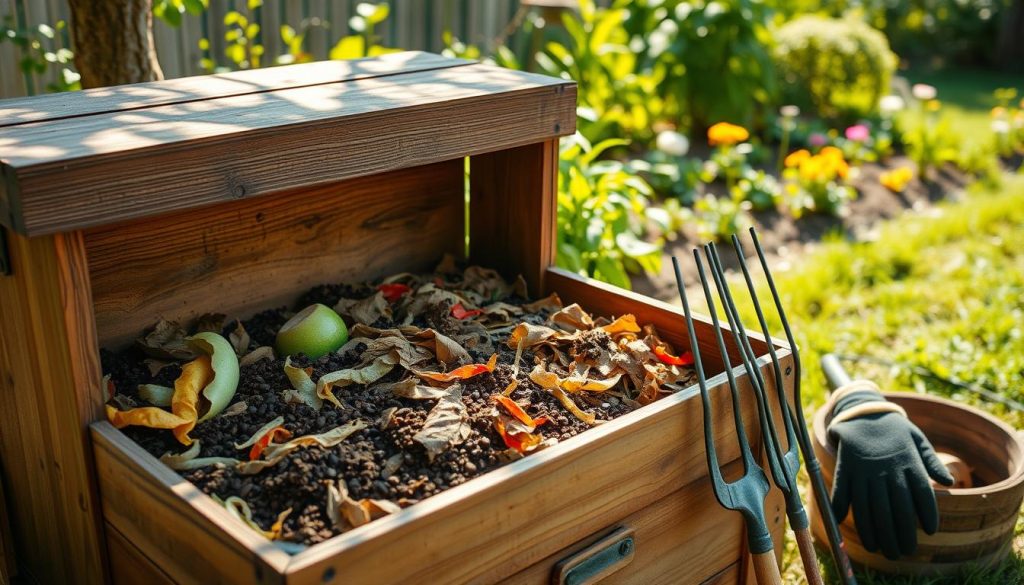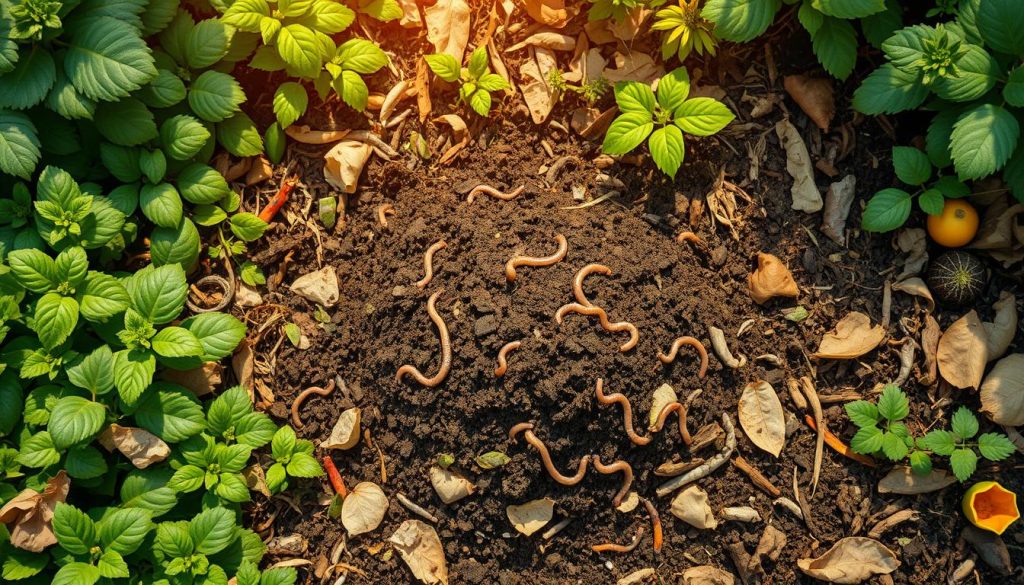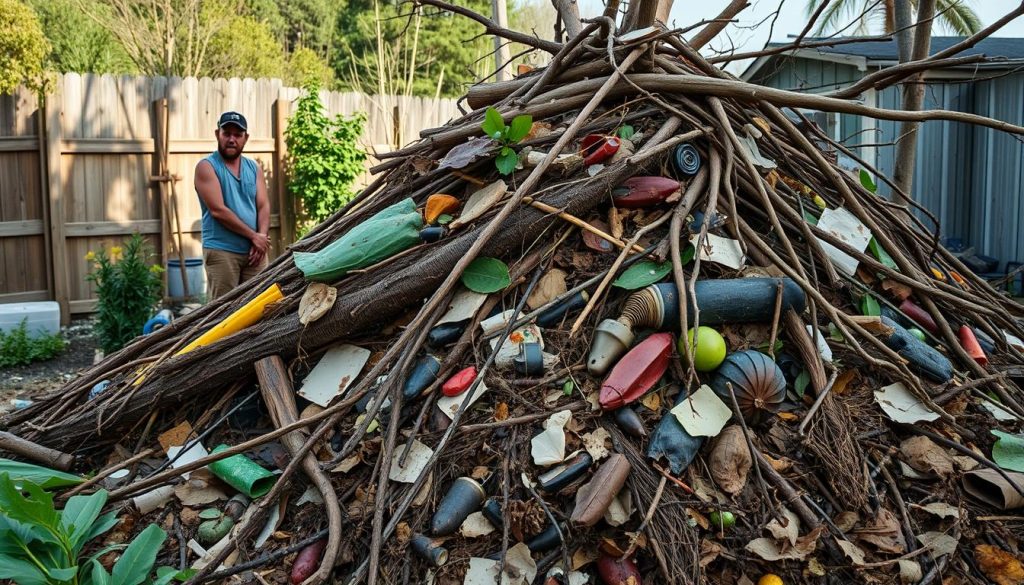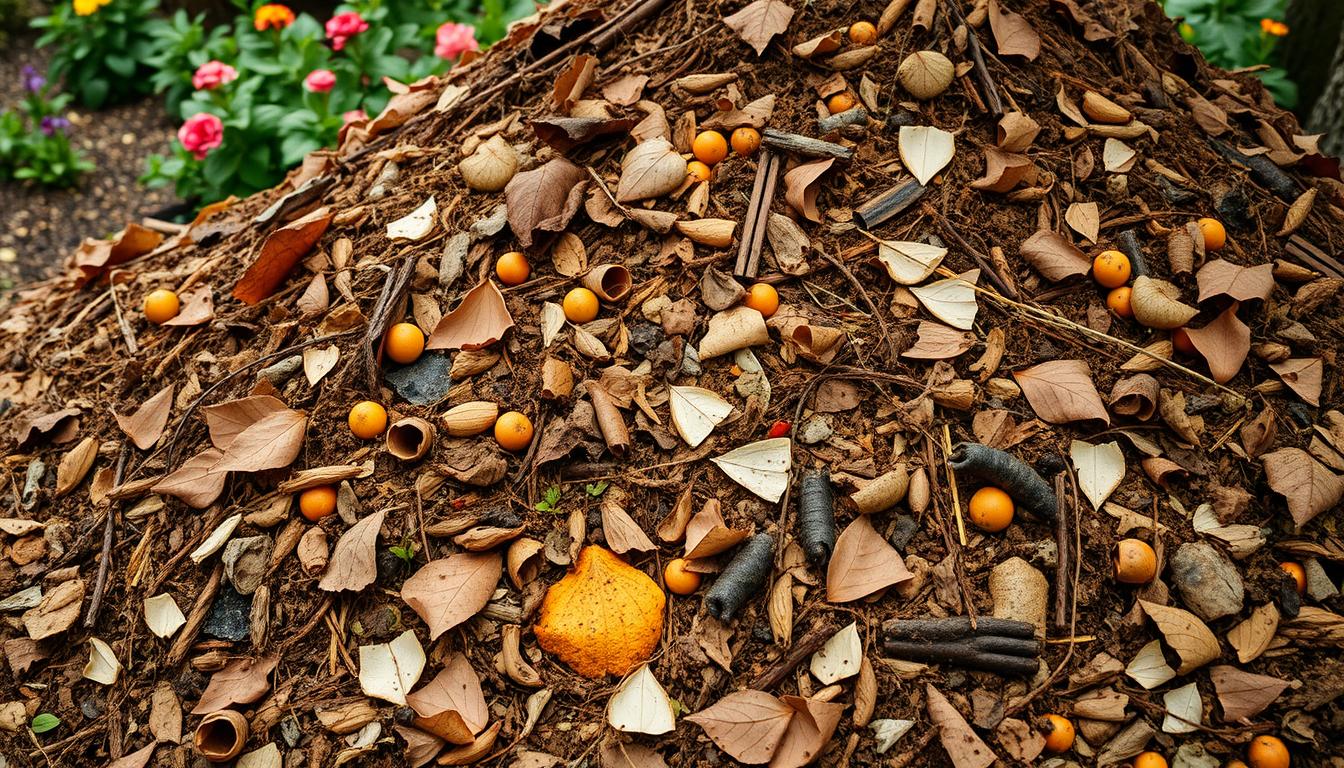As a beginner in composting, I made several mistakes. These mistakes slowed down the process and made the compost less effective. I learned that avoiding common errors is key to a successful compost. By sharing my mistakes, I hope to help you avoid them and make rich soil for your garden.
Composting is a natural process that needs patience and a basic understanding. By avoiding common mistakes, you can have a successful compost. I’ll share my mistakes so you can learn from them and make better compost.
Not Understanding the Basics of Composting
Exploring composting, I see how key it is to grasp the basics. Not knowing what to compost can ruin your efforts. Learning about the carbon to nitrogen ratio is vital.
Composting turns organic waste into a soil booster. It needs a mix of carbon-rich and nitrogen-rich materials. Aim for 2/3 carbon to 1/3 nitrogen.
What is Composting?
Composting is nature’s way of breaking down organic stuff. It’s great for reducing waste and enriching soil. Knowing what to compost helps you succeed.
The Importance of Carbon to Nitrogen Ratio
The carbon to nitrogen ratio is crucial. A 2/3 to 1/3 mix ensures the compost heats up and breaks down well. This balance is key to a good compost.
Understanding composting basics and following the right rules helps you succeed. Keep your materials balanced to make nutrient-rich soil for your garden.
Skipping the Preparation Steps
As I keep going on my composting journey, I’ve learned that getting ready is crucial. Chopping up big materials into smaller pieces is a great practice. It increases the surface area and speeds up decomposition. This is key for items like branches and leaves, which take a long time to break down otherwise.
It’s also important to make sure everything is clean and free of contaminants. This means avoiding adding plastic and metal. Many people make mistakes by adding meat and dairy, which can attract pests and cause bad smells. By preparing my materials properly, I can make sure my compost is safe for my garden and helps my plants grow well.
Chopping Up Larger Materials
Chopping up big materials is a key step in composting. You can use a chipper or just cut them up with pruning shears. Some benefits of doing this include:
- More surface area for microorganisms to work on, speeding up breakdown
- Better aeration, which helps decomposition happen faster
- Less chance of matting, which blocks air from reaching the compost pile’s center
Making Sure Everything is Clean
It’s also vital to make sure everything is clean and free of contaminants. This means removing plastic and metal and avoiding meat and dairy. By following these best practices and avoiding common mistakes, I can create a healthy compost pile. This will help my garden grow well.

Ignoring the Composting Environment
As I continue on my composting journey, I’ve learned that the composting environment is key. The right spot for your compost pile is crucial for efficient breakdown. A spot with good air and sunlight is best, keeping the right temperature and moisture.
For beginners, knowing about aeration is important. Regularly turning the pile keeps oxygen in and bad smells out. These simple steps help avoid common mistakes that can ruin your compost.
Choosing the Right Location
When picking a spot for your compost pile, think about a few things. It should be close to water, easy to get to, and protected from the weather. These considerations help create the perfect spot for your compost.
Understanding Aeration Needs
To keep your compost pile aerated, try these:
- Turn the pile regularly to maintain oxygen levels
- Add brown materials, such as leaves or straw, to help absorb excess moisture
- Use a compost aerator to loosen compacted materials
By following these tips and avoiding common mistakes, you can create a healthy compost pile. It will give you rich, nutrient-dense soil for your garden.

Overloading the Compost Pile
As I keep learning about composting, I’ve found that overloading the pile is a big mistake. It can cause bad smells, attract pests, and lower the quality of the compost. To fix this, it’s key to know how much green and brown stuff to use.
Good composting is all about the right mix of green and brown materials. Green stuff, like food scraps and grass, has lots of nitrogen. Brown stuff, like leaves and twigs, has lots of carbon. Mixing them right creates a pile full of nutrients and good microbes.
Identifying the Right Amount of Green and Brown Materials
To get this mix right, I stick to a simple rule. I aim for 2/3 brown materials and 1/3 green materials. This balance helps the microbes grow and keeps the pile healthy.

Signs of Overloading
So, how do you know if your pile is too full? Look out for strong ammonia smells, lots of flies, and a pile that’s too wet or dry. Spotting these signs early helps you avoid mistakes and make great compost for your garden.
By following these tips and watching out for problems, you can get good at composting. Remember, it takes patience, attention to detail, and a willingness to learn. With time and practice, you’ll make a compost pile that makes your garden grow strong.
Not Monitoring Moisture Levels
As I continue on my composting journey, I’ve learned that monitoring moisture levels is crucial. Not keeping the moisture at the right level can slow down the composting process. To avoid this, I regularly check the moisture level, following some simple tips.
A good way to check moisture is by doing a squeeze test. I take a handful of compost and squeeze it. If it crumbles, it’s too dry. If it forms a tight ball, it’s too wet. The ideal moisture is like a damp sponge, just right.
How to Determine Proper Moisture
To keep the moisture right, I follow some simple steps:
- Check the compost pile regularly for signs of dryness or too much moisture
- Use a moisture meter to get an accurate reading
- Perform the squeeze test to determine the moisture level
Adjusting Moisture with Water or Dry Materials
Once I know the moisture level, I can adjust it. I add water or dry materials to get it right. By following these tips, I can keep the moisture just right and avoid common mistakes.
Patience is Key in Composting
Composting is a journey that requires patience and effort. Knowing how long it takes to turn waste into valuable soil is key. This process can take weeks or even months, depending on several factors.
Understanding the Timeline for Composting
Give your compost time to go through its stages. The first breakdown can take weeks, and the final stage may take months. Keep an eye on your compost and adjust as needed for success.
Signs Your Compost is Ready
When your compost is ready, it will smell earthy and feel crumbly. These signs mean it’s ready to feed your garden. By following the right steps and avoiding mistakes, you’ll have a healthy garden.

